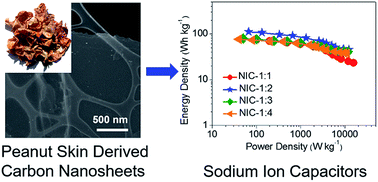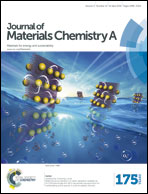Excellent energy–power characteristics from a hybrid sodium ion capacitor based on identical carbon nanosheets in both electrodes†
Abstract
We created a hybrid Na ion capacitor (NIC) with a unique architecture and exceptional energy–power characteristics. Both the anode and the cathode are based on peanut skin derived carbon nanosheets fabricated by simultaneous carbonization and activation or by carbonization alone. The tens of nanometer thick (down to 20 nm) – high surface area (up to 2070 m2 g−1) nanosheets possesses a disordered structure for copious reversible binding of Na at the carbon defects. They are also hierarchically micro–meso–macro porous, allowing facile ion transport at high rates both through the pore-filling electrolyte and in the solid-state. When employed as sodium ion battery anode, the carbon shows a tremendous reversible (desodiation) capacity of 461 mA h g−1 at 100 mA g−1 and excellent rate capability, e.g. 107 mA h g−1 at 5 A g−1. The optimized NIC device displays highly favorable Ragone chart placement, e.g. 112 and 45 W h kg−1 at 67 and 12 000 W kg−1, retaining 85% of its capacity after 3000 cycles.

- This article is part of the themed collection: JMC A Editor’s choice collection: Recent advances in batteries

 Please wait while we load your content...
Please wait while we load your content...